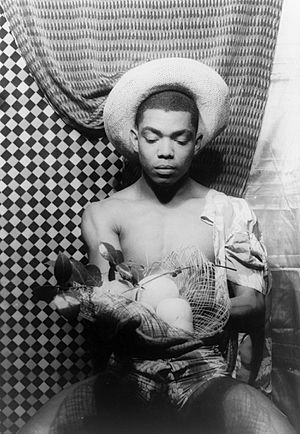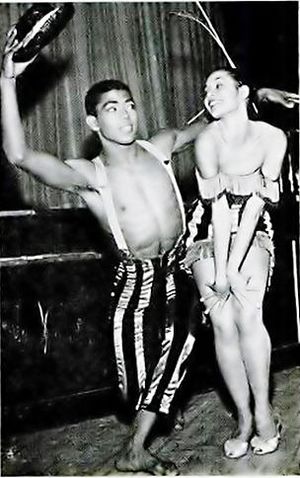Alvin Ailey facts for kids
Quick facts for kids
Alvin Ailey
|
|
|---|---|

photographed by Carl Van Vechten, 1955
|
|
| Born | January 5, 1931 Rogers, Texas, U.S.
|
| Died | December 1, 1989 (aged 58) Manhattan, New York City, U.S.
|
| Occupation | Dancer, choreographer |
| Awards | Presidential Medal of Freedom Kennedy Center Honors |
Alvin Ailey Jr. (born January 5, 1931 – died December 1, 1989) was an amazing American dancer, director, and choreographer. He was also an activist who started the famous Alvin Ailey American Dance Theater (AAADT). He created AAADT and its school, the Ailey School, to be a safe place for Black artists. His goal was to show the world the rich and diverse experiences of African Americans through dance.
Alvin Ailey's dance style mixed theater, modern dance, ballet, and jazz with Black cultural movements. His dances were full of hope and helped people around the world learn about Black life in America. His most famous dance, Revelations, is one of the most popular and performed ballets ever.
In 2008, the United States Congress called AAADT a "vital American cultural ambassador to the World." This means the dance company helps represent American culture to other countries. That same year, New York City and New York State honored AAADT for its 50th anniversary.
Contents
Early Life and Dance Beginnings
Alvin Ailey was born in Rogers, Texas, in 1931. This was during the Great Depression, a time when many people struggled financially. It was also a time when the southern United States was very racist and segregated. This meant Black people were kept separate from white people and faced a lot of unfair treatment.
Alvin's father left when he was very young. He and his mother, Lula Elizabeth, had to work hard in cotton fields and as housekeepers in white homes. These were some of the only jobs available to them. To escape the difficulties, Alvin found comfort in church. He would sneak out at night to watch adults dance. He also kept a journal, which he did his whole life. His childhood involved moving often as his mother looked for work.
In 1941, Alvin's mother moved to Los Angeles for better job chances. He joined her a year later. In 1946, he saw his first professional dance show. He watched the Katherine Dunham Dance Company and Ballet Russe de Monte Carlo perform. This sparked a new joy in him! But he didn't get serious about dance until 1949. His friend, Carmen de Lavallade, convinced him to try a dance class with Lester Horton.
Alvin studied many dance styles at Horton's school. It was one of the first dance schools in the United States that welcomed students of all races. Horton became his mentor. Even though he loved dance, Alvin also studied languages and writing at UCLA and San Francisco State. He even performed a nightclub act called "Al and Rita" with Maya Angelou when he lived in San Francisco. Eventually, he returned to Los Angeles to focus on dance with Horton.
Alvin Ailey's Dance Career
Alvin joined Horton's dance company in 1953. He made his first performance in Horton's show, Revue Le Bal Caribe. Sadly, Horton passed away suddenly that same year. Alvin, though young, stepped up to lead the company and finish their shows.

In 1954, Alvin and Carmen de Lavallade were asked to join a Broadway show called House of Flowers. They were known as a great dance team in Los Angeles. During this show, Alvin met Geoffrey Holder, who became a lifelong friend and artistic partner. After House of Flowers, Alvin danced in other shows, but he really wanted to create his own dances. He started gathering dancers to perform his unique ideas.
Alvin Ailey American Dance Theater
In 1958, Alvin Ailey started the Alvin Ailey American Dance Theater. He wanted to celebrate Black culture through dance. The company's first show was at the 92nd Street Y. It included his first major work, Blues Suite. This dance showed people having fun to blues music, then returning to everyday life when church bells rang.
In 1960, Alvin premiered his most famous dance, Revelations, also at the 92nd Street Y. For Revelations, Alvin used his "blood memories" from growing up in Texas. He remembered the church, spiritual songs, and the blues music that surrounded him. The ballet shows many feelings, from sadness to pure joy. It ends with an exciting finale called "Rocka My Soul in the Bosom of Abraham."
Even with their success, the Ailey company struggled to get steady performances in America. The U.S. State Department helped them go on international tours. They traveled across Asia in 1962 and to Africa in 1966 and 1967. These tours helped the company gain fame abroad.
In 1970, Alvin announced he was closing the company because they had so few bookings. But then, the State Department sponsored a tour to Russia. The company was a huge hit there! Their performances were shown on Moscow television and seen by over 22 million people. The audiences loved them so much that the dancers took over 30 curtain calls on closing night. When they returned home, the company performed in New York City, and all their shows quickly sold out. After 13 years, the Alvin Ailey American Dance Theater was a huge success! In 1972, it became a resident company of New York City Center.
Alvin Ailey created more than 100 ballets for his dancers. But he also wanted the company to perform dances by other choreographers. He believed in showing many different voices through dance. He was proud to hire artists based on their talent, no matter their background. This was important because, at the time, Black dancers often faced unfair treatment due to racism. Alvin also choreographed ballets for other famous companies like American Ballet Theatre.
The Ailey School
In 1969, Alvin founded the Alvin Ailey American Dance Center. He started it with Pearl Lang, a famous dancer and choreographer. Their goal was to make dance and arts training available to communities that didn't have many resources. They started with 125 students in Brooklyn. A year later, the school moved to Manhattan, near the Lincoln Center.
The school grew a lot over the years. In 1998, it partnered with Fordham University to offer a Bachelor of Fine Arts degree in dance. In 1999, it was renamed The Ailey School. Later, it moved into a large new building called The Joan Weill Center for Dance. Today, The Ailey School is the biggest place in New York City dedicated to training dancers.
Judith Jamison was a very important dancer for Alvin Ailey. She joined the company in 1965 and inspired many of his works. In 1971, she performed Cry, a solo dance Alvin dedicated to his mother and Black women everywhere. After Alvin's death in 1989, Judith Jamison became the artistic director of the company.
Other key people in the company include Sylvia Waters, who led Ailey 2 (a junior company for students) starting in 1974. Masazumi Chaya danced with the company for 15 years and later became the associate artistic director.
Personal Life
Alvin Ailey didn't like being called a "Black choreographer." He wanted to be known simply as a choreographer, focusing on his art.
In 1980, Alvin went through a difficult time and was diagnosed with bipolar disorder. During his recovery, Judith Jamison helped lead the dance company.
Death
Alvin Ailey passed away on December 1, 1989, at the age of 58.
Works
Choreography
- Blues Suite, Alvin Ailey American Dance Theatre, 1958.
- Revelations, Alvin Ailey American Dance Theatre, 1960.
- Cry, solo created for Judith Jamison, Alvin Ailey American Dance Theatre, 1971.
- The River, American Ballet Theatre, 1970.
Stage Performances
- House of Flowers, Broadway, 1954 – Actor and dancer.
- Jamaica, Broadway, 1957 – Actor and lead dancer.
Stage Choreography
- Antony and Cleopatra, Metropolitan Opera House, 1966.
- Mass, Metropolitan Opera House, 1972.
See also
 In Spanish: Alvin Ailey para niños
In Spanish: Alvin Ailey para niños
- Postmodern dance
- 20th century concert dance
- List of dance companies


